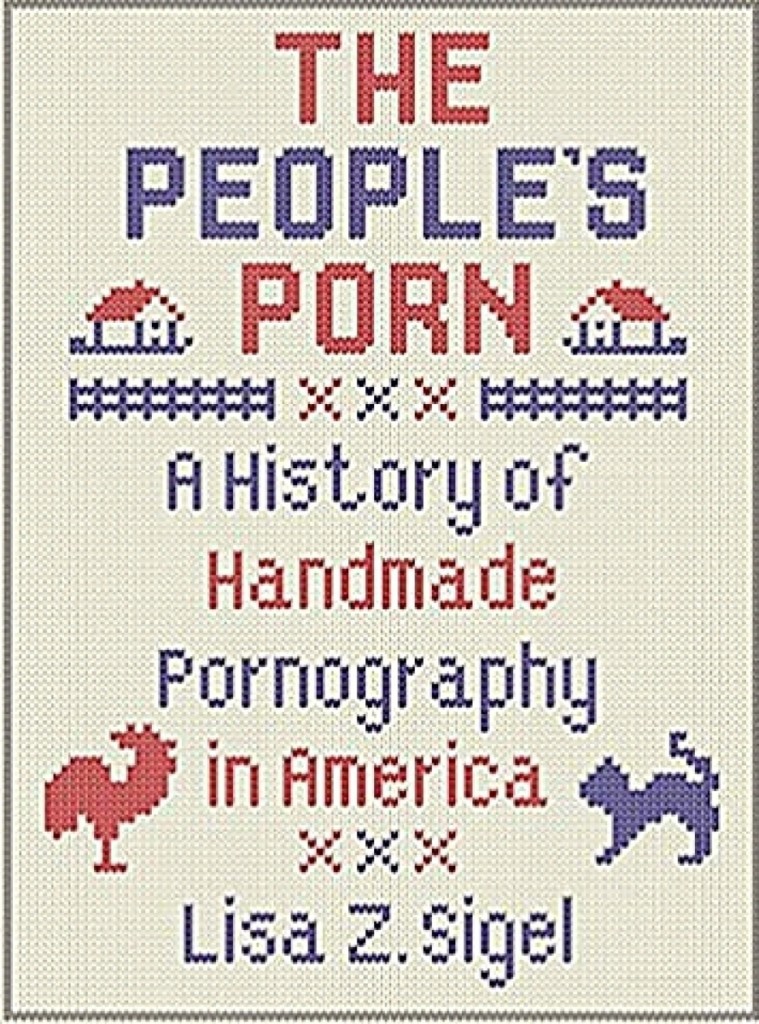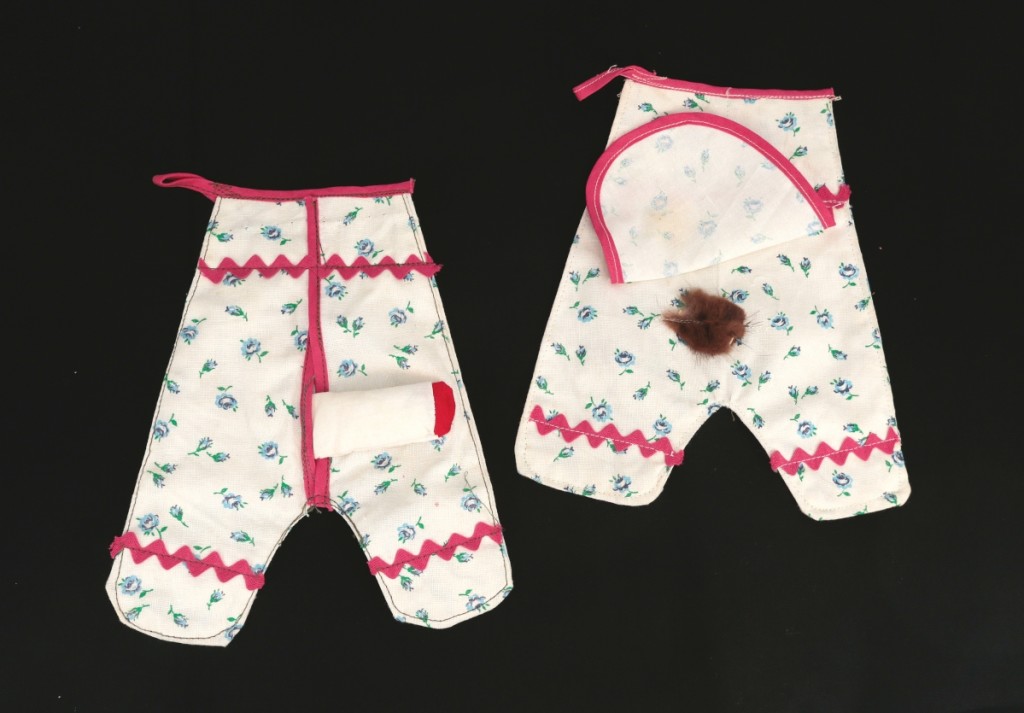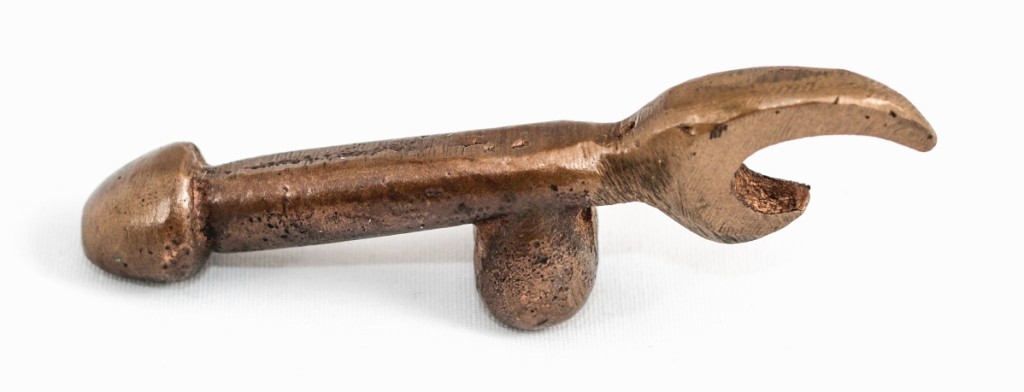I was at an antiques show a few years ago when a dealer grinned widely as I approached. “Hey, come here, I want to show you something,” he said, as he turned to a highboy and pulled out a folk art carved wood figure of a man. When he adjusted a part of the figure, an erection appeared from within. We both laughed and shared a quick moment looking it over. Erotic or not, it was a fine carving and the surprise was undoubtedly special. After we were through giggling, the dealer walked over to his highboy and placed it back inside the drawer, hiding it away once again. He likely repeated the same act multiple times that show, pulling it from the drawer when those he felt comfortable with approached, knowingly or perhaps unknowingly following a tradition as old as time where we discretely share these kinds of objects with the near and dear. Lisa Z. Sigel has opened the drawer for good with her new book, The People’s Porn: A History of Handmade Pornography in America, where the historian speaks to the prolific creation of pornography and our unique culture that both harbors and represses it.
You acknowledge a number of antique dealers who aided you in the preparation of your book. What did you learn from them?
I talked to many people – Steve Powers, Carl Hammer, Mark Rotenberg, Patrick Bell, Arthur Liverant, Ivan Stormgart – and they put me in touch with collectors who also shared their knowledge. Antique dealers are this vast source of knowledge. Most of them remember everything that has ever passed through their hands. They know how much things cost and whether it was a good price or not. They know who made something, when and where. Historians are used to working with documents, but dealers have all this knowledge in the back of their heads about artifacts and none of what they know is ever published. They clued me in to when things are important and when I should take note. They also gave me a crash course in how to recognize artistry and workmanship.
You write that this is an archive of discrete objects. What can we learn by pulling back the veil on these deeply personal works?
We can learn something by pulling them together. A collector might have one, a dealer might have two. But usually you don’t see a whole group of them together. When we bring them together, we see an unacknowledged folk history or outsider history that people don’t recognize because they’ve never been thought of as a cohesive whole. When we look at them together, we start seeing what motivates groups of people around sexuality. It’s not an individual perversity but something that has a broader social import.
Some pieces seem to border more on humor than sexuality, do you distinguish?
I don’t. We sometimes think that pornography must be serious and that you’re not supposed to laugh at sex. But if you look at some of these objects, you realize that people do laugh about sex and always did. There’s a peach pit monkey in my book, for example. This monkey has an enormous erection that it holds in one hand. In the other hand, it thumbs his nose at the viewer. It was carved by a prisoner around 1940. What better symbol for a prisoner than this tiny peach pit carving of a monkey thumbing his nose back at the warden who confiscated it. An anthropologist said that some things are good for thinking. Sex is good for thinking.
You make a distinction between what people buy and what people make. What does the self-made object tell us that the mass-produced cannot?
Handmade objects let you hear people communicate in their own idiom. If you think of Aristotle’s Masterpiece (circa 1684), which other scholars have looked at to talk about our vernacular sexuality, it was a mass-produced pamphlet from Europe. It had a tradition in the European publishing trade before it came to America. I don’t think that’s where you’re going to find the American vernacular. The American sexual vernacular is going to come from handmade pamphlets, handmade carvings and scrimshaw that allowed people to develop their own voices about sexuality. Those voices might be a little less cosmopolitan, a little less polished and a little more rural. But they spoke to American ideas and culture.
In what ways are they less polished?
They were less culturally polished. My first book was on Nineteenth Century British commercial pornography, and there you’ll find absolutely beautiful etchings. They were struck off in copies at 150 to 300 a run, but they were professional products that came from a commercial tradition. When you compare those books and those images with the homemade, there’s a roughness in handmade objects that you don’t see in commercial productions. But the handmade objects are also richer in meaning – there’s room for emotions in handmade material that commercial materials didn’t engage with because that’s not where the money was. With handmade objects, their makers created the thing that they wanted to envision rather than trying to communicate what someone else wanted to see. It’s more in tune to someone’s heart’s desires, only mediated by their skill.
Does the skill make a difference to you?
It doesn’t make a difference to me, it makes a difference in the marketplace and where the objects end up. The masterful works will wind up in exquisite collections and they certainly deserve to be there. But for the historian in me, I have a place for the inexpertly done, because I want to know what people were expressing in that moment. I don’t need to be an art critic. I’m a historian who is trying to see a text or artifact in its context.
What’s the most primitive example in the book?
There are some artifacts where you have to squint to see an erection. There’s one in which the erection is made from a pencil fragment, for example. It’s primitive not in terms of its style but in terms of the makers unwillingness to put in the work. There are also many examples of people taking magazine illustrations and adding genitalia. I mention a cookie in the collection of Kinsey.
A cookie?
It’s a cookie in the Kinsey Institute archive. It’s a phallic cookie with little chocolate sprinkles as the pubic hair. It’s not the most expertly made cookie, and I think that after 60 or 70 years it’s not even edible.
Tell me about the Kinsey Institute.
I worked there extensively and saw thousands of pieces. Seeing the Kinsey collections helped me establish this baseline for the range of objects available. The Kinsey Institute is a culturally rich institution with such a wealth of art, books, pamphlets, papers, you name it. It is also financially impoverished and if anyone reading this is wealthy, it would be a wonderful thing to finance it. Kinsey, himself, I think of him as a magpie, he collected everything. He had an enormous vision. Things that other people thought of as trash, he would be willing to collect and store and figure out what to do with later. The altered illustrations I mentioned earlier, most people would have called them trash but he thought they had intrinsic value. When he was working with prisons, they would send him objects made by prisoners and he would store and archive them. The result is this time capsule of sexual artifacts from the 1950s and 1960s, which were the richest periods for donations.
From the early Twentieth Century on back, what kinds of forms have you illustrated in your book?
Today we think of pornography as photographs or videos, but before then there were carvings, plaques, drawings, paintings, writings, and so on. Once you have the development of a mass-produced consumer culture, with newspaper and magazines and posters, you start having handmade or homemade pornography transformed by it. The belief is that consumer culture wipes out homemade art, but it doesn’t. It inspires fan fiction and the reuse of commercial culture. Whatever media people used in their daily lives, they made into pornography.
In American history, were any mediums more prolific than others?
Carvings – everyone had a knife to whittle with. I came across a few ceramics, but not as many as I would have thought. No doubt one of your readers will have more. And then paper art. Lots of people had access to writing materials and they would create their own illustrations, or write their own pornography or transcribe some they had seen, thus making it their own.
Are coins a notable medium?
Coins are valuable for historic research in general, because of their durability and ability to be dated. Many handmade objects can’t be dated, but coins have a date. They also show the spread and relationship between individuals and the state. When you begin to add in transformed coins, it adds this funny gloss on an area of respectable scholarship. They are little miniatures versions of obscene objects: for example, there’s a flying eagle coin that someone made into a flying phallus. The remade coins span periods and cultures. This book is focused on America, but there are examples of French and English coins that were transformed. I gave a talk in England and a member of the audience was from a Scottish archeological museum. He said, “they’re pretty much in every site we dig up.”
You touch on miniatures, why are so many of these pieces small?
They were easier to hide away. It’s what Carl Hammer calls “the plumber problem.” We have all these beautiful objects all over our house, but then the plumber comes to fix the pipe and they judge us by the art on our walls. A lot of the things people saved were smaller because you could hide them away.
Were there any objects in particular that made an indelible impact on your book?
The scrimshaw at Mystic Seaport. They are such beautiful objects, so well authenticated. These were made by master craftsmen.
Is historical American pornography any different than that of other cultures and countries?
We don’t know. There’s very little done on the history of pornography, period. Little done on the history of commercial pornography and less on handmade pornography. I’m hoping we’ll find out. I’ve come across Italian trench art that looks similar to America’s, but did they overlap? I’m hoping people will get excited and start excavating their own national tradition.
Was handmade pornography more acceptable in ancient times?
Yes. Absolutely. There was no industrial pornography in ancient times so it was all handmade. We can see those sexual objects as art and we can accept that it’s important as a way to understand ancient societies. We can understand it in the far past and see how important it is, but when it comes closer in time to us, we get more uncomfortable.
Are there any notable times in American history where specific environments fostered the prolific creation of pornography?
Whenever you see all male environments, pornography pops up. The Nineteenth Century was very sex-segregated, men socialized with men and women with women, and a lot of communities followed that pattern. Cowboys, loggers, miners, whalers – I suspect there was pornography coming out of those communities. Prisoners, for example, were not allowed to have pornography. By the way, most are still not allowed nor are they allowed to masturbate, it’s a safety standard. So prisoners would end up making their own pornography.

The People’s Porn: A History of Handmade Pornography in America is Amazon’s #1 new release in the study of pornography. It is available for $40 hardcover at Amazon.com.
It sounds like men were largely the creators?
With many of these objects, the assumption is that they were made by men, but there’s no proof. There is no provenance attached to them. But some objects were made by women. Women used traditional female crafts to create pornography. My favorites are the potholders. There were always two and one side had a penis and the other a vulva. Every time I’ve shown these in a talk, someone starts laughing and talking about some aunt or another who would break them out at holidays. There are so many versions of the potholders.
What about periods of American history that explicitly repressed pornography?
In the aftermath of the Civil War, Anthony Comstock comes to mind. He worked with the post office to try to eliminate obscenity. That was 1869-1890. He became less effective in the early Twentieth Century and then died in 1915. His successor never had the same clout or charisma. Also, things changed after World War I. People were less concerned with obscenity and more concerned with recovery both from the Spanish flu and from the war.
Did religion play a part?
Religion had a lot to do with wanting to keep people from being polluted by sexuality. Comstock talked about novels that would inflame people’s passion. He wasn’t talking about pornography, just commercial novels. His starting point was any commercial culture that wasn’t biblical in nature, anything more obscene than that was going to corrupt. But what saved a lot of these handmade objects is that these were private, they were not out in public. People could make them and laugh with a friend over them, but they weren’t circulating, which helped save them.
I imagine much handmade pornography has likely been destroyed.
Anthony Comstock was really delighted to explain that he destroyed pornography and obscenity by the tonnage. He wouldn’t even allow the names of books to be put into the judicial record. Because of that, we don’t know what the first American pornographic novel is. We have a real lack of knowledge about the history of pornography of the Nineteenth Century. H. S. Ashby, an important British bibliographer, wrote about a New York photographer in the 1850s and mentioned the thousands of prints that this photographer made, but we don’t have any of them. Imagine if we could see what nudes looked like before the Civil War. All of those are gone.
Do you feel curators shy away from pornography?
I think they recognize its value but they don’t know what to do with it. I think curators keep the objects and treat them well, but they don’t necessarily display them. Hopefully my book will encourage them to find a way to display this material.
There’s still a stigma to researching pornography. Tell me about some of the roadblocks you’ve experienced.
People are uncomfortable with my work. At best, I get good-natured teasing but I’ve also been turned down for jobs and fellowships. There are no grants available for the study of pornography, not since the controversy over the Mapplethorpe exhibit in 1989. Since then, no public funding could be used for the study of pornography. And recently, it’s been quite difficult to get any money to fund research on sexuality at all. It’s been a labor of love on my part. It’s strange because sexuality is an intellectually rich area but people are embarrassed, and they would rather it disappear. There’s no other sort of subject where the study of something can get you in trouble with the law. I also study World War I, I look at photographs, memoirs and diaries, and war was awful, but the materials left behind are widely available to study. Whereas pornography, it’s still problematic to study even 100 years later. When people make claims that pornography is getting better or worse, that’s a statement of change over time, but if we don’t know about what has happened over time, we shouldn’t make that statement, we need a historical record in order to understand the change. That’s been my career – to try to understand that record.
-Greg Smith







